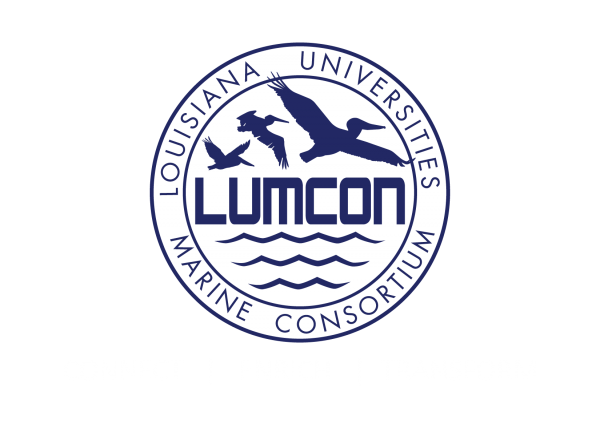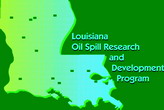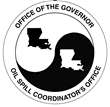LIBRARY
MAIN CATALOG (Electronic Resources/LUMCON Library)
Click here to search the Dispersants Bibliography
Click here to search Effects of Offshore Oil and Gas Development Bibliography
ABOUT THE LIBRARY
The LUMCON Library collection was originally housed in Ellender Memorial Library, located at Nicholls State University in Thibodaux, Louisiana. After completion of the DeFelice Marine Center in 1986, the collection was moved to its present location. Since that time, the Library has become an active resource center for LUMCON faculty and staff as well as Consortium member institutions, visiting researchers, students, and the public.
The library contains a computer lab and several study spaces available to visiting students, scientists, or groups (such as attendees of a writing retreat).
The collection and development of library materials reflects LUMCON’s research programs. The collection has approximately:
- 4,600 monographs
- 5,800 bound volumes
- 200 journal titles
- 26 current journal subscriptions
- 850 maps
- 35 atlases
- 3,600 government documents
- 1,500 reprints
In addition, the library houses a complete collection of research products generated by DeFelice Marine Center personnel since LUMCON’s inception.
HOURS OF OPERATION
- The LUMCON Library is staffed Monday through Friday from 7:00 AM to 3:30 PM. All visitors are welcome during these hours.
- The Library is closed to the public on weekends, state holidays, and when the librarian is not on site. Before visiting the facility, please call 985-851-2875 to ensure the Library will be open.
- All LUMCON staff, summer students, and resident visitors have 24-hour access to the Library. If the doors to the Library are locked, the security guard will open them for you.
CIRCULATION
- Books can be checked out by filling out a card at the circulation desk. The length of time a book can be checked out varies depending on the patron’s status. Books may be renewed by contacting the department, but all items are subject to recall at any time.
- Interlibrary loan service is available for LUMCON faculty, postdocs, lab personnel, and summer students. Although we strive to get items at no charge, the patron may be asked to pay for interlibrary loan charges under certain circumstances.
- Reserve items, reference materials, and journals must remain in the Library. The Library has no photocopier, but copies or scans can be made in the LUMCON main office.
- All materials must be checked out before removal from the Library, without exception.
- Library materials can be placed on reserve for summer classes. A list of items to be placed on reserve should be provided to the librarian as soon as possible.
- When returning material that has been checked out, please drop off items at the circulation counter.
Food is not allowed in the Library under any circumstance. Drinks are only allowed with prior approval by the librarian or the security guard.
INTERNSHIP PROGRAM
The LUMCON Library is available as an internship site for graduate-level students who have completed at least two semesters toward a Master’s degree in Library and Information Science. Applications will be accepted on a continuing basis and internships may be completed during any semester. Prior library experience or an undergraduate degree in science is desirable, but not necessary. Credits will be awarded based on the number of person-hours completed (40 person-hours per credit hour).
The internship will consist of both field experience, encompassing many operations of a special library, and a special project in technical services. The Librarian will give the intern an overview of reference services, technical services, library administration, and budgeting, and will guide the intern through special projects. The LUMCON Library uses SIRSI/Dynix’s Symphony Integrated Library System as well as OCLC for Cataloging/Interlibrary Loan services.
Contact the Librarian for more information or to apply for an internship.
ACKNOWLEDGMENTS
We would like to thank the following individuals for their guidance and input when creating the Dispersants Bibliography:
-
- Victoria Broje, Per Daling, Alun Lewis, and Francois-Xavier Merlin offered valuable assistance in the early phases of this project. Per Daling’s support was especially noteworthy, by providing conference proceedings that otherwise could not be obtained.
- Deborah Ansell, ITOPF’s librarian, contributed by sharing her sizeable list of library holdings on dispersant publications with us, and filling in gaps where existing citation information was incomplete.
- Likewise, Julie Anne Richardson, librarian for Environment Canada, compiled a publication listing on dispersants housed in her collection, which provided us with additional citations for our project.
- Qianxin Lin at Louisiana State University provided API conference proceedings for us to use in transcribing abstracts.
- Nancy Kinner at the Coastal Response Research Center provided encouragement, focus, and connected us with some of the aforementioned people.
- Finally, Don Davis and Karen Reeder Emory at OSRADP deserve special mention for all of their help and direction during the span of this project.
 |
 |
 |
The LUMCON Library is a member of the International Association of Aquatic and Marine Science Libraries and Information Centers (IAMSLIC), the Southeast Affiliate of IAMSLIC Libraries (SAIL), and the Louisiana Library Network and Information Consortium (LOUIS). Additionally, the Library has access to OCLC Cataloging/Interlibrary loan services.
Click here to search LUMCON’s e-Library catalog using the LOUIS portal.
DISPERSANTS BIBLIOGRAPHY
Thirty mangroves, Avicennia marina (Forsk.) Vierh. var. resinifera (Forst.) Bakh., in a coastal fringe in St. Vincent, South Australia, were exposed to crude oils (Arabian Light and Tirrawarra), dispersant BP-AB, and oil/dispersant mixtures (1:1) to establish toxicity of the pollutants. Following exposure, leaf damage, defoliation, flowering and fruiting, and pneumatophore damage were monitored over a three-year period. oil/dispersant mixtures increased short-term toxicities, with significant defoliation being observed. Before the end of the first year, significant new leaf production was observed in plots spiked with the Arabian Light crude oil/dispersant mixture, compared to Arabian Light crude alone. No differences in leaf growth were noted in the Tirrawarra and Tirrawarra/dispersant mixtures. There was no observed effect on flower/fruit production. Short-term pneumatophore damage was noted for all treatments
This paper reviews results from field and laboratory studies and challenges the validity of some widely held beliefs regarding dispersant use. The author stresses that decisions considering using dispersants must be made in consideration of a range of priorities, including the protection of one sensitive habitat which may necessitate sacrifice to another. Site-specific priorities must by identified and dispersion options must be considered with reference to all possible spill control strategies
The concept that an oil spill might be immobilized on the surface of a body of water and subsequently dispersed has been advanced. The exploratory studies reported here demonstrate that an ultrahigh molecular weight elastomer, known to retard oil spreading, can be sued in conjunction with an oil soluble surfactant to disperse the oil in water. The elastomer retards the dispersability of the oil to some extent, but at concentrations of the elastomer sufficient to prevent oil spreading there is still significant dispersion
A spiked-exposure toxicity test procedure has been developed, in which initial dispersant concentrations are diluted at a standardized rate to provide a simple model of exposure experienced in the field. Traditionally, acute dispersant toxicity has been described using constant-concentration exposures of 24 to 96 hours. Constant concentrations are unrealistic in the field because of the dilution effects of wind and wave conditions required for dispersant application. The spiked-exposure procedure has been adopted in California as a standardized tool for comparing dispersant toxicity. Five dispersants have been tested using four Californian species. Tests using oil and dispersant-oil mixtures are being developed
The toxicity of seawater dispersions of a chemical dispersant to two marine crustaceans was investigated in the presence and absence of various quantities of a non-toxic mineral oil. From the results and a physical-chemical partitioning analysis, a limiting value of the oil-water partition coefficient of the toxic compounds is deduced suggesting that essentially all of the toxic compounds in the dispersant will partition into solution in water following dispersant application to an oil spill. This conclusion simplifies interpretation and prediction of the toxic effects of a dispersed oil spill
The toxicity of second-generation dispersants and component surfactants to a wide range of marine organisms is concisely reviewed. Recent studies are particularly emphasized. The paper offers a current perspective on oil spill dispersant toxicology, a prerequisite for understanding the toxicity of chemically dispersed hydrocarbons. Known lethal and sublethal thresholds are summarized for various dispersants (concentrated, water-immiscible, water-miscible). Existing information on the comparative toxicology of surfactants and dispersants is evaluated; the data base on a current formulation (Corexit© 9527) is thoroughly examined. Current studies in our laboratory with brine shrimp and endemic marine copepods are briefly described. Factors known to influence the toxicity of dispersants are described. The sites and physiology of toxic action of dispersants, though incompletely understood, are discussed; respiratory and nervous systems appear to be primary targets of action. Hypothesized relationships between dispersant toxicity and effectiveness, and the toxicity of chemically dispersed oil are discussed. Recommendations for future research are also given
Many different approaches have been used recently in aquatic toxicity research for preparing and analyzing test solutions and dispersions of hydrocarbons, dispersants, hydrocarbon/dispersant mixtures, and oiled sediment mixtures. This variety is a result of the novelty of this research field. Therefore, much of the published work is difficult to compare, summarize, and interpret. Both uniform and unique methods will contribute to a better understanding of the toxicology and potential field effects of chemically dispersed oils in marine waters. This paper summarizes some current methods and recommends adoption of certain principles and uniform methods for water and sediment studies. Specific items discussed are (1) choice of oils and dispersants; (2) degree of “weathering” of the experimental oils; (3) preparation of water soluble fractions and oil dispersions in water; (4) choice of dispersant/oil ratios, especially considering dispersant effectiveness; (5) reagent mixing and premixing; (6) dosing of sediments; (7) chemical analysis of dispersed hydrocarbons; and (8) choice of exposure concentrations, composition, and durations. This paper is intended to encourage more uniformity in test conditions. This need for uniformity has been recognized internationally for several years
Use of the dispersant, Oilsperse 43, increased the dispersion of Venezuelan Guanipa crude oil. The resulting mixture was more homogeneous and the oil slick less viscous than in the oil tank. The dispersant appeared to retard formation of the familiar “crust” on the surface. A weathered crude oil plus dispersant mixture with an oil concentration of 250 μg/l was lethal to over 50% of the test organisms, green sea urchins, within 4 days. No mortalities occurred among urchins exposed to the crude oil treatment
Juvenile flounder and common mussel from the Baltic Sea were kept in Corexit 7664 (50 µg/l) and cadmium (5 µg/l)-contaminated, recirculated, sea-water systems for 200 days at 15 degree C and 20 ppt S. Accumulation of cadmium with exposure time was measured in several fish tissues and in mussel. There were no differences in the cadmium accumulation by tissues with or without the addition of Corexit 7664. No acute effects of the contaminants on the experimental animals could be noted. Final cadmium concentrations, reached for all biological matter analysed, were 4 times higher than in full-strength sea water
The present study was conducted to assess the toxicity of the water-accommodated fraction (WAF) and the chemically enhanced WAF (CE-WAF) of selected crude oils for both weathered and fresh oil. Test organisms included two standard test species, Mysidopsis bahia and Menidia beryllina, and a commercially important Florida marine fish, Sciaenops ocellatus. tests ascertaining LC50 values were conducted under continuous exposure and spiked (declining exposure using flow-through toxicity chambers) conditions using Venezuelan Crude Oil (VCO), Prudhoe Bay Crude Oil (PBCO), and COREXIT® 9500 dispersant on the above species. Data suggest that the dispersant is less toxic than the WAF and CE-WAF of the tested crude oils. The toxicity of the CE-WAF of fresh VCO is similar to that of other oils under continuous exposure conditions, but may be slightly more toxic to some species under spiked exposure conditions. The CE-WAF of fresh VCO appears to be less toxic than the corresponding WAF for M. bahia, M. beryllina, and S. ocellatus. fresh VCO appears to be much more toxic to M. bahia and M. beryllina than weathered VCO in spiked exposure tests for both the WAF and CE-WAF. The WAF of PBCO is apparently less toxic to the test organisms than the corresponding WAF of fresh VCO. The LC50 of M. bahia with CE-WAF fractions of both fresh VCO and PBCO are similar, while the same PBCO CE-WAF fraction is less toxic for M. beryllina than fresh VCO CE-WAF. The toxicity of oils and dispersants were lowest in the spiked exposure weathered oil tests, which may be the most representative of an oil spill under natural environmental conditions
Hsp60 induction was selected as a sublethal endpoint of toxicity for Brachionus plicatilis exposed to a water accommodated fraction (WAF) of Prudhoe Bay crude oil (PBCO), a PBCO/dispersant (Corexit 9527®) fraction and Corexit 9527® alone. To examine the effect of multiple stressors, exposures modeled San Francisco Bay, where copper levels are approximately 5 7g/L, salinity is 22‰, significant oil transport and refining occurs, and petroleum releases have occurred historically. Rotifers were exposed to copper at 5 7g/L for 24 h, followed by one of the oil/dispersant preparations for 24 h. Batch-cultured rotifers were used in this study to model wild populations instead of cysts. SDS-PAGE with Western Blotting using hsp60-specific antibodies and chemiluminescent detection were used to isolate, identify, and measure induced hsp60 as a percentage of control values. Both PBCO/dispersant and dispersant alone preparations induced significant levels of hsp60. However, hsp60 expression was reduced to that of controls at high WAF concentrations, suggesting interference with protein synthesis. Rotifers that had been preexposed to copper maintained elevated levels of hsp60 upon treatment with WAF at all concentrations. Results suggest that induction of hsp60 by chronic low-level exposure may serve as a protective mechanism against subsequent or multiple stressors and that hsp60 levels are not additive for the toxicants tested in this study, giving no dose-response relationship. The methods employed in this study could be useful for quantifying hsp60 levels in wild rotifer populations
The nutritional state of an organism can affect the results of toxicity testing. Here we exemplified this fact by examining the effect of nutritional deprivation on heat shock protein 60 (hsp60) production in the rotifer Brachionus plicatilis following exposure to two proven inducers of hsp60, a water-accommodated fraction of crude oil (WAF) and a dispersed oil preparation (DO). Both DO and WAF exposures of unfed rotifers resulted in significantly greater hsp60 levels than that of fed DO and WAF exposed rotifers at 8 h: 870 and 3100% of control, respectively. Results clearly demonstrate that a poor nutritional state potentiates stress protein induction upon exposure to water-soluble petroleum products. It is therefore critical to define the organismal nutritional status when reporting toxic responses
In laboratory tests simulating conditions found in Prince William Sound, two test methods were used to compare various test conditions and ratios of Corexit 9500/Alaska North Slope crude oil (1:10, 1:20, 1:50) to find the optimal effectiveness of dispersant in seawater at 8°C. Tests involved sampling each dispersant at four contact times, and five weathering times. Results show that greatest dispersion was achieved when weathering time was minimized and a short contact time was made available
Washington State has imitated the development process for a dispersant pre-approval policy. In order to be more effective under the aegis of the Regional Response Team (RRT), the pre-approval policy should, however, cover all of Region X, rather than only a given state within the region. The Region X RRT has, therefore, instigated an environmental impact statement (EIS) for dispersant use in the coastal waters of Washington and Oregon. The objective of this study is to develop recommendations for pre-approval so that a spill response can be immediate and therefore efficient and effective. Preparation of the EIS has been funded by industry through a Clean Sound Cooperative contract to Woodward-Clyde Consultants. The first step in the study is to define those operational factors that limit the areas to be considered. The study then follows the dispersant decision guides summarized by the American Petroleum Institute to further define oil types, spill situations and geographical areas where dispersants are a viable option. Finally, there is an analysis of the environmental trade-offs associated with alternative treatment methods and with nontreatment, using the comparative modeling technique developed by S. L. Ross Environmental Research, Ltd. The EIS document will be issued by the Washington Department of Ecology (WDOE) and will focus on areas where dispersant use could be beneficial in terms of ecological trade-offs. Based on the study, a statement from the State of Washington Department of Ecology is anticipated to be promulgated by the end of 1990
Sublethal concentrations of the oil dispersant Gulf Agent 1009 Lot No. LS-3712 are shown to have an arrestant effect on swimming in the winter flounder (Pseudopleuronectes americanus). The effect involves suppression of endogenous tidal rhythm and reductions in swimming amplitude. The effective threshold of a pure fatty acid polyoxyethylene ester - the main active ingredient in the oil dispersant - was found to lie between 0.1 and 1.0 mg l-1 for decrease in swimming amplitude
Polyoxyethylene ethers are more toxic to aquatic fauna than polyoxyetheylene esters. Polyoxyethylene (4) lauryl ether is 9 times more toxic than polyoxyethylene (14) monolaurate at the ILL to Salmo salar L., and 14,000 times more toxic at the 96-h LC50 to Gammarus oceanicus Sergestråle
Lethal response of Atlantic salmon parr, as 96-h LC50, is semi-logarithmically related to the number of moles of ethylene oxide in the polyoxyethylated surfactant. 96-h LC50 of polyoxyethylene (10) monolaurate = 7.5 mg l1, polyoxyethylene (10) lauryl ether = 3·5 mg l-1, and polyoxyethylene (10) octadecyl amine = 0·2 mg l-1. Evidence is presented which suggests that polyoxyethylene esters with up to 18–20 moles of ethylene oxide are partially detoxified in the animal, resulting in changes in lethal response. Possible physiological explanations for the relationship between polyoxyethylene chain length and lethality involve uptake rates and attainment of a critical concentration of surfactant at the unknown active site
This database consists of citations found in journals, conference proceedings, government reports and gray literature covering over 40 years of published research on oil spill dispersants. Citations were collected from 1960 through June 2008. This bibliography was compiled and edited by John Conover, Associate Librarian at LUMCON, and funded by a grant from the Louisiana Applied and Educational Oil Spill Research and Development Program (OSRADP).
EFFECTS OF OFFSHORE OIL AND GAS DEVELOPMENT BIBLIOGRAPHY
|
Quarterly Issues
|
Compilations
|
- Biology
- Ecological, anatomical, and physiological effects of oil and/or gas, Species as biomarkers, PAH uptake and bioaccumulation, etc.
- Chemistry/Geochemistry/Geology
- Biochemistry, Biodegradation, Bioremediation, Hydrocarbon degradation, Environmental sampling, Soil contamination, etc.
- Engineering/Physics
- Technological advancements in facility/equipment design and use, Spill response and recovery equipment, Physical properties of oil and gas, etc.
- Environment/Ecosystem Management/Spills
- Environmental assessment and management, Oil and/or gas spill description and analysis, etc.
- Socioeconomic/Regulation/General
- Social and economic ramifications, Politics, Governmental policy and legislation, Organizational policy, General interest, etc.
This bibliography is a quarterly compilation of current publications (citations with abstracts) from a wide variety of electronic and print information sources relating to offshore oil and gas development. It is compiled and edited by John Conover, Associate Librarian at LUMCON. Items listed may or may not be available at the LUMCON Library. Items without annotations were unavailable for perusal prior to publication.
All questions about using library facilities, locating library resources, or searching LUMCON catalogs should be directed to the Librarian.


